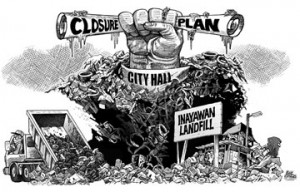What’s next for Inayawan?

Officially it’s “closed” to garbage.
In reality, about 60 percent of the city’s refuse still ends up in this facility that has long breached the limits of its capacity.
Will the Rama administration follow through on its December 2011 order closing Cebu City’s “smokey mountain”?
What’s taking so long?
Even junkshop operators like Inayawan barangay captain Rustom Ignacio leave their garbage along the road, blocking half of the lane to the dumpsite, landfill manager Randy Navarro told the Cebu City Council in last Wednesday’s session.
Article continues after this advertisementThese “mini dumpsites” cited by the Environment Management Bureau (EMB) won’t be cleared if Navarro’s report that the barangay captain is operating one of them is true.
Article continues after this advertisementRemember how the goal was to help Inayawan scavengers survive the closure by providing alternative livelihood?
In a closed dumpsite, they were still needed to pick and sort out residual garbage in a Materials Recovery Facilities (MRF) for recycling into products that can be sold in the market.
In the past year, Cebu City has been coping by “diverting” garbage to Consolacion town.
The high cost of doing that is emerging more clearly in budget deliberations in the City Council. Instead of paying daily rental at P4,000 per truck to haul the garbage to Consolacion, the lease should be on a per-trip basis, Navarro recommends.
It’s a band-aid at best.
We’re supposed to see a reduction in the volume of garbage collected – if steps of recycling, composting and reusing and done with vigor at the household and barangay level. That’s not happening in Cebu City.
The crux of the problem remains the execution of an honest to goodness solid waste management program.
Again, what’s taking so long?
If you go by the anguished sounds of the head of the Solid Waste Management Board, it’s because of slow action by Councilor Nida Cabrera to let the company Greenergy present its $102 million waste-to-energy poposal.
Cabrera, who pioneered community-based waste segregation and recycling in Barangay Luz, knows how to build a grassroots system that is sustainable. She’s not about to endorse a magic-bullet solution for Cebu City that she can’t scrtunize. Ecology groups are cautious about high-tech vendors selling what can turn out to be harmful incineration.
Mayor Michael Rama should be clear: Which way are you going in this?